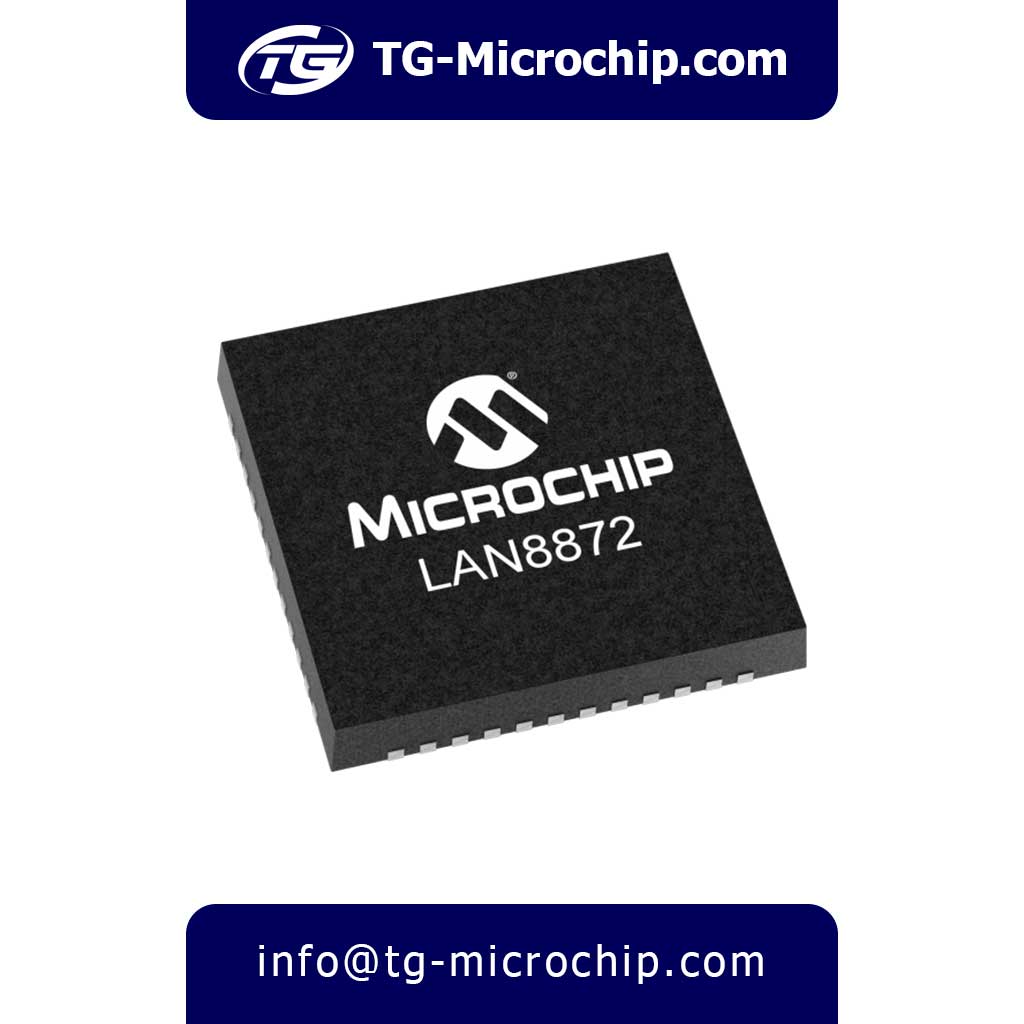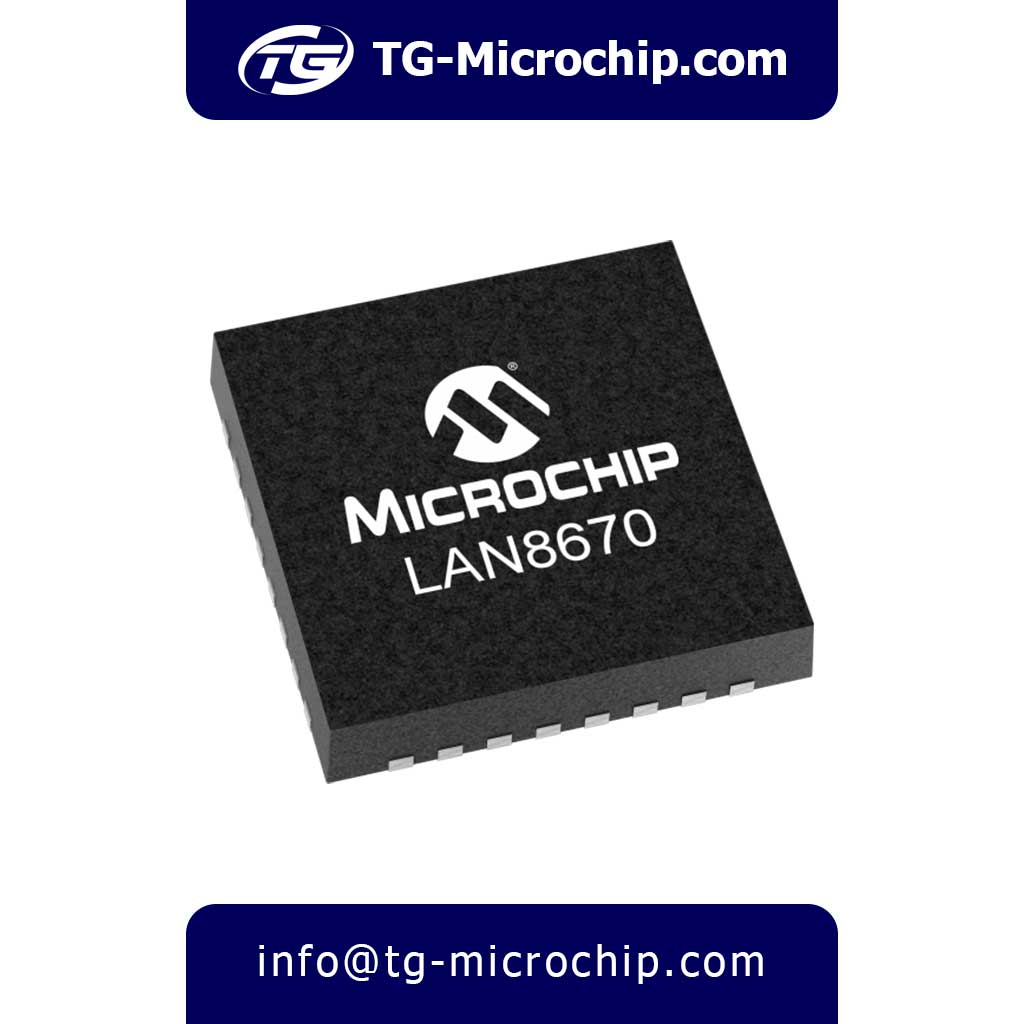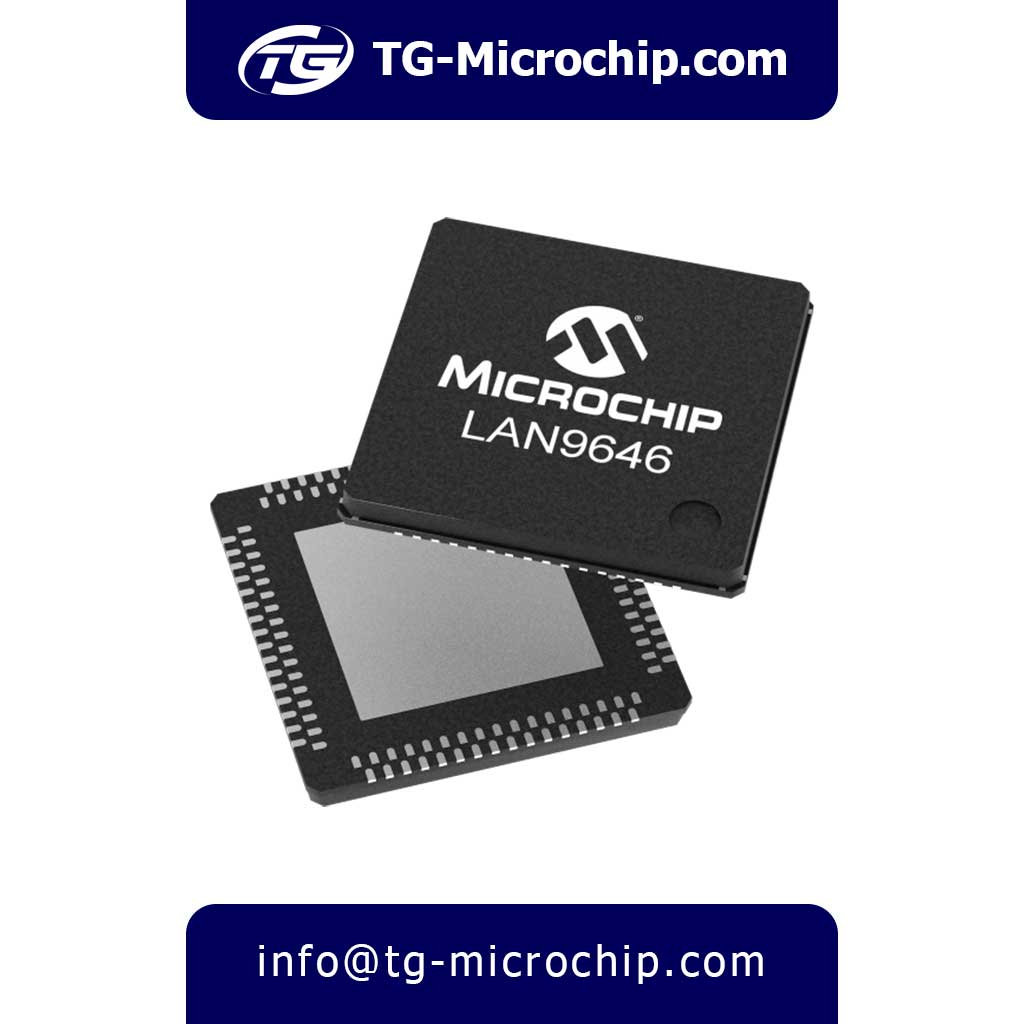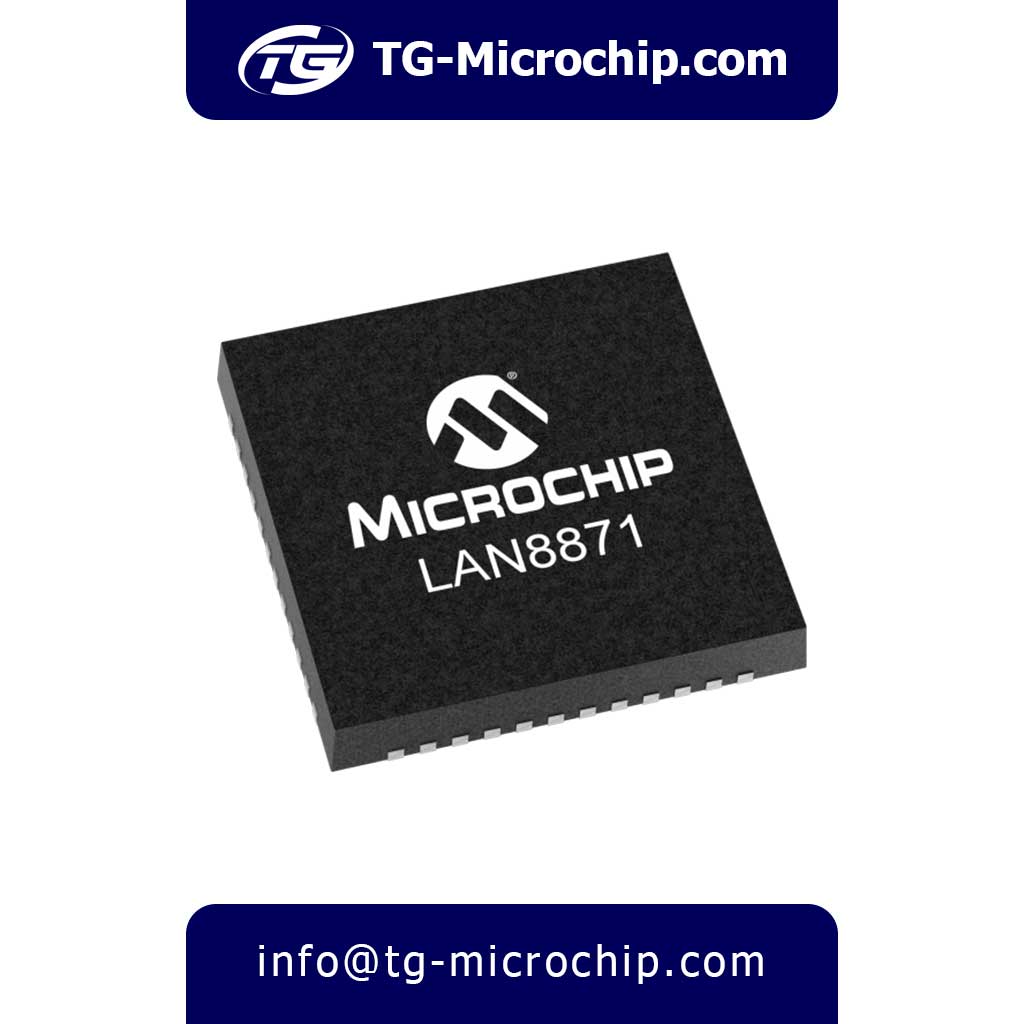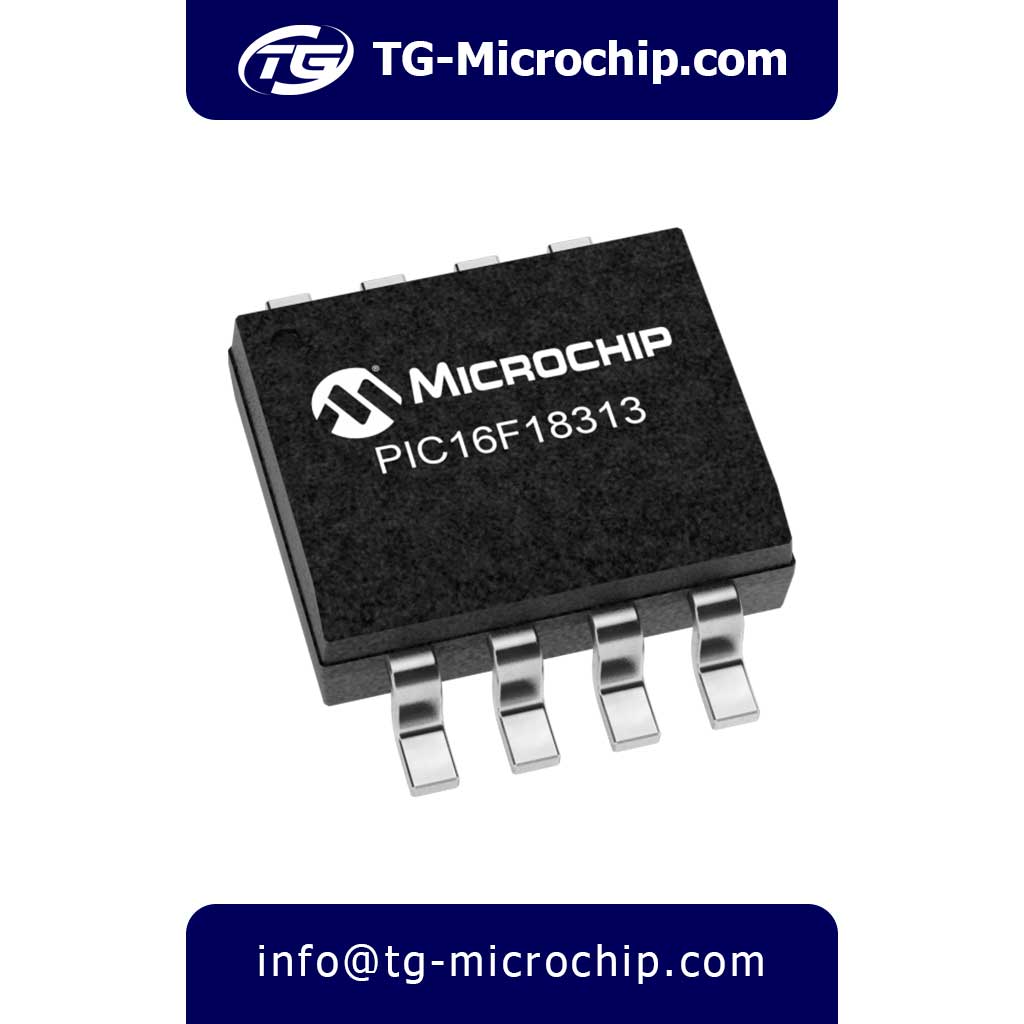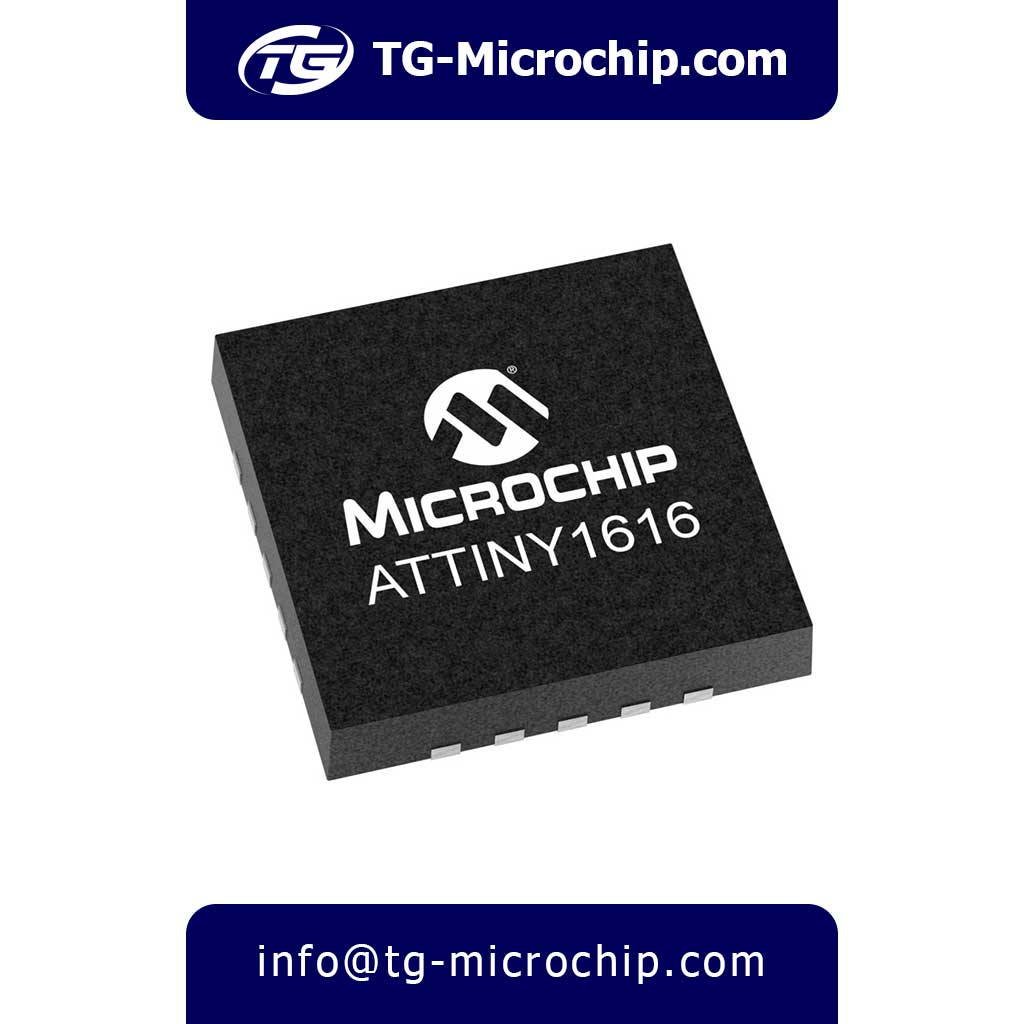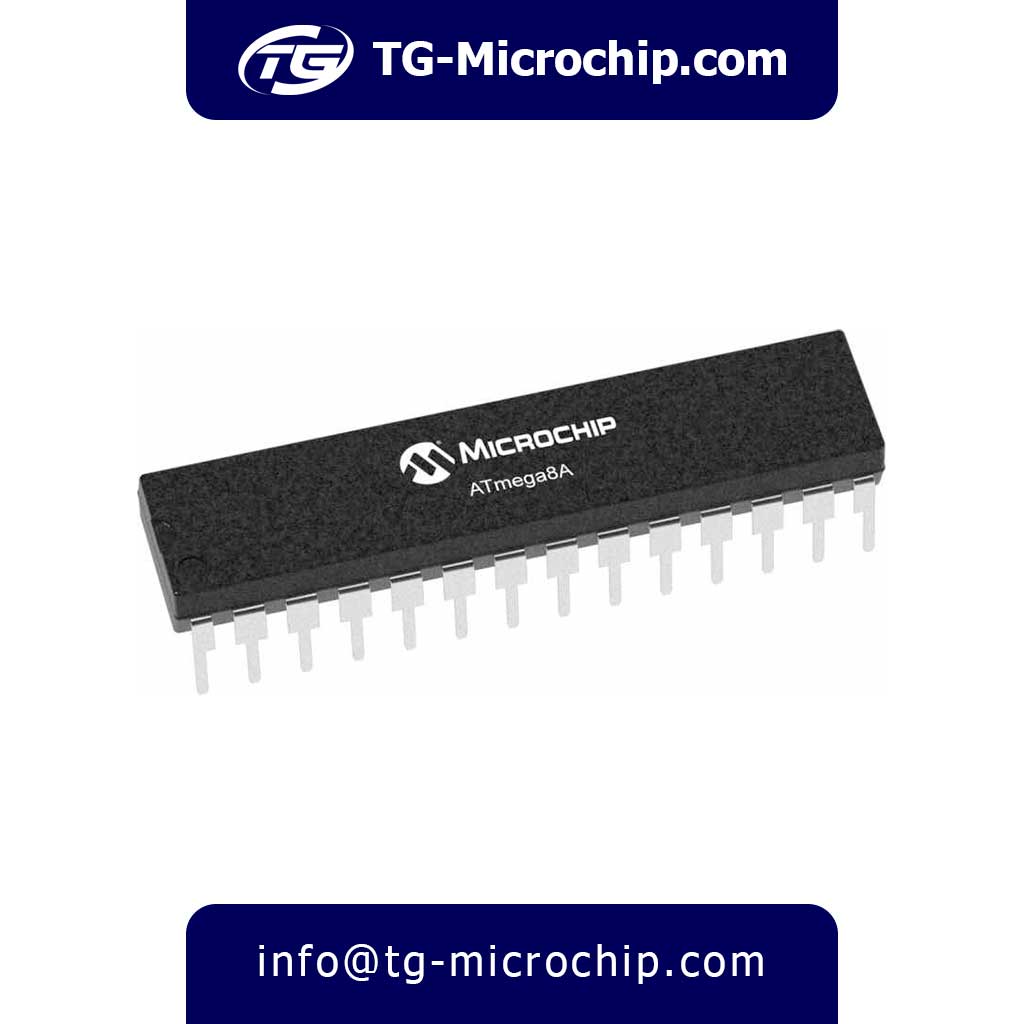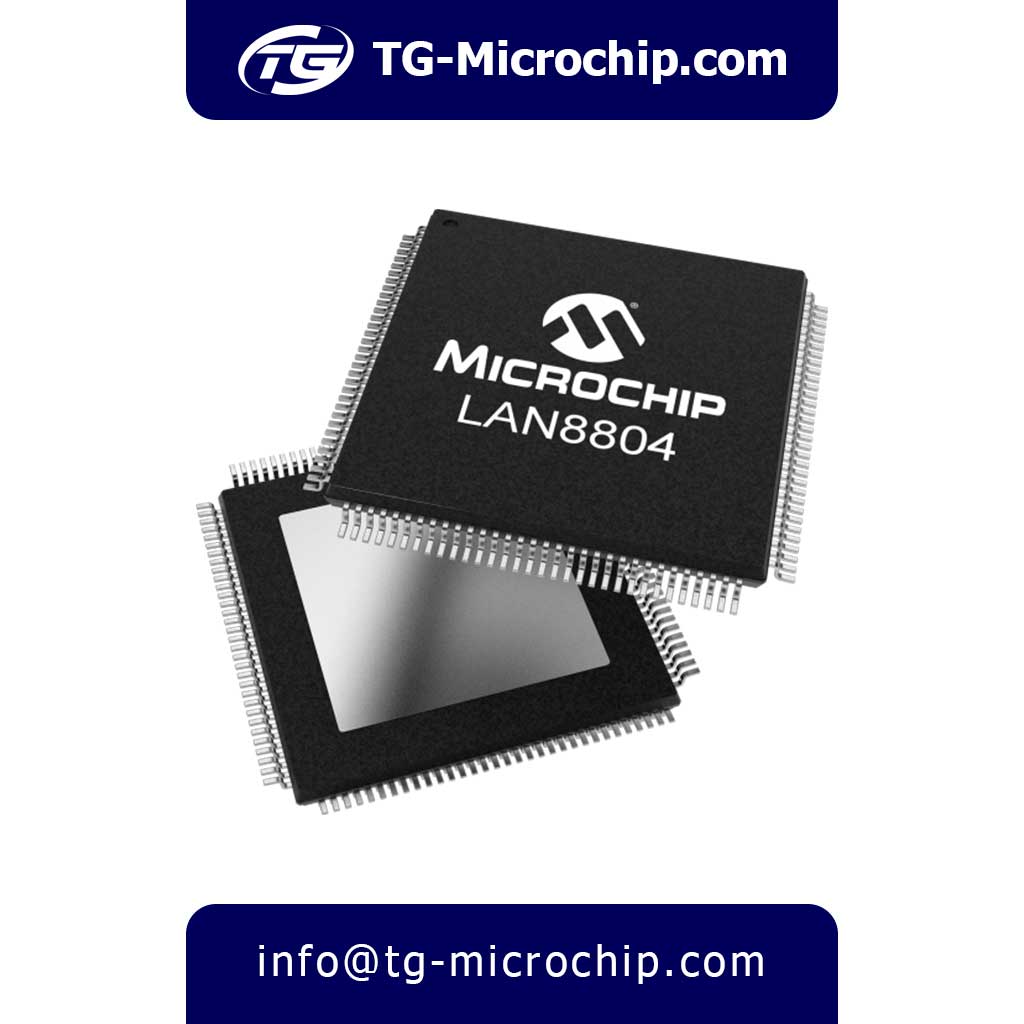For order or price inquiry of LAN8872-I/PUA Microchip Technology Please click on Buy Order button and fill the RFQ form we will check out inventory and offer you our best price.
Quick Access
About
The LAN8872-I/PUA by Microchip Technology is a high-performance Ethernet PHY transceiver designed for industrial and automotive applications. It supports both 100BASE-T1 (100 Mbps) and 1000BASE-T1 (1 Gbps) Ethernet standards over single-pair shielded twisted-pair (STP) cabling, complying with IEEE 802.3bw (100BASE-T1) and IEEE 802.3bp (1000BASE-T1) protocols. The device operates within an industrial temperature range of -40°C to +85°C, making it suitable for harsh environments like automotive ADAS, industrial automation, and robotics. Its 48-pin VQFN package (7 x 7 mm) features wettable flanks to facilitate automated optical inspection (AOI) during PCB assembly.
A key feature of the LAN8872-I/PUA is its SGMII (Serial Gigabit Media Independent Interface), which provides a high-speed connection to MAC-layer processors. Unlike some counterparts in the LAN887x series, this model exclusively supports SGMII and omits RGMII, optimizing it for streamlined designs requiring deterministic latency. The transceiver incorporates FlexPWR® technology, allowing flexible I/O voltage support (1.2V to 3.3V) to interface with mixed-voltage systems. Additionally, its EtherGREEN™ energy-efficient technology minimizes power consumption, drawing as low as 16 µA in sleep mode (OPEN Alliance TC10 compliant).
The LAN8872-I/PUA is engineered for Time-Sensitive Networking (TSN), supporting critical protocols like IEEE 802.1AS-2020 for time synchronization and IEEE 1588-2019 for Precision Time Protocol (PTP). These features enable deterministic communication in real-time applications such as factory automation and automotive networks. The device also includes advanced diagnostics, such as Signal Quality Indicator (SQI) and cable defect detection, to enhance system reliability. Loopback modes and false packet rejection further aid in debugging and performance optimization.
For functional safety, the transceiver is ISO 26262 ASIL-B ready and AEC-Q100 qualified, meeting stringent automotive and industrial standards. It boasts robust ESD protection (±8 kV HBM) and complies with EMC/EMI standards like CISPR 25 and ISO 11452-2. The wettable-flank VQFN-48 package not only improves solder joint inspection but also aligns with automotive-grade reliability requirements.
Target applications include automotive Ethernet backbones (e.g., infotainment, ADAS), industrial IoT (IIoT), and medical devices requiring deterministic, low-latency communication. With TSN readiness, low-power modes, and industrial-grade durability, the LAN8872-I/PUA bridges the gap between high-speed data transmission and harsh-environment resilience.
Key Features
Physical Layer Features:
- Compliant with IEEE 802.3bw (100BASE-T1) and IEEE 802.3bp (1000BASE-T1) standards
- Supports operation over 15-meter single-pair shielded twisted-pair (STP) cable (Type A)
- Integrated DSP with adaptive equalization for signal integrity
- Crosstalk cancellation technology
- Baseline wander compensation
Interface Features:
- SGMII (Serial Gigabit Media Independent Interface) MAC interface
- 1.25 Gbps SerDes capability
- Supports both 100 Mbps and 1 Gbps data rates
Power Management Features:
- FlexPWR® technology supporting multiple I/O voltage levels (1.2V, 1.5V, 1.8V, 2.5V, 3.3V)
- EtherGREEN™ energy-efficient technology
- Multiple power modes: Active, Sleep (16 µA), Power-Down (10 µA)
- Wake-on-LAN support via IEEE 802.3az (Energy-Efficient Ethernet)
Time-Sensitive Networking (TSN) Features:
- IEEE 802.1AS-2020 time synchronization
- IEEE 1588-2019 Precision Time Protocol (PTP)
- Support for Time-Aware Shaping (802.1Qbv)
- Frame Preemption (802.1Qbu) capability
Diagnostic and Monitoring Features:
- Signal Quality Indicator (SQI)
- Cable open/short detection
- PRBS (Pseudorandom Binary Sequence) loopback modes
- False packet rejection
- CRC error detection
- Over-temperature detection
- Under-voltage monitoring
Packaging and Physical Features:
- 48-pin VQFN package (7mm × 7mm)
- 0.5mm pitch
- Wettable flank package design
- Matte Sn (Annealed) lead finish
- MSL 3 (Moisture Sensitivity Level)
Compliance and Safety Features:
- AEC-Q100 qualified for automotive applications
- ISO 26262 ASIL-B Ready
- ±8 kV HBM (Human Body Model) ESD protection
- CISPR 25 Class 5 EMI compliance
- ISO 11452-2 immunity compliance
- IEC 61000-4-6 immunity compliance
- RoHS compliant
- Halogen-free
Signal Processing Features:
- Adaptive DSP-based equalization
- Digital clock recovery
- Jitter attenuation
- Line driver with programmable output amplitude
Configuration Features:
- MDIO/MDC management interface
- Programmable LED indicators
- Software-configurable features through register settings
- Hardware reset pin
Manufacturing Features:
- Tape and reel packaging
- Suitable for automated PCB assembly
- AOI (Automated Optical Inspection) compatible package design
Applications
1. Adware & Advertising Software
- Description: Software that generates revenue by displaying intrusive advertisements, often bundled with freeware/shareware.
- Behaviors:
- Injects pop-up ads, banners, or in-text ads into web browsers
- Installs browser extensions/add-ons without clear consent
- Replaces legitimate ads with paid advertisements (ad-fraud)
- Tracks browsing history to serve targeted ads
- May create desktop shortcuts to promotional websites
- Often persists through browser restarts or system reboots
2. Software Bundlers (Aggressive Installers)
- Description: Installation wrappers that package multiple programs together, often with pre-selected options.
- Behaviors:
- Uses “quick install” options that automatically install extras
- Hides optional components in custom/advanced installation flows
- Frequently changes during updates to include new bundled offers
- May install browser toolbars, system utilities, or trial software
- Often connects to multiple download servers during installation
3. System Optimizers (Performance Boosters)
- Description: Utilities claiming to improve PC performance through questionable means.
- Subtypes:
- Registry cleaners
- RAM optimizers
- Driver updaters
- Duplicate file finders
- Behaviors:
- Performs exaggerated system scans showing false problems
- Requires payment to “fix” identified issues
- May disable legitimate system services to show “improvements”
- Often runs unnecessary background processes that actually slow systems
4. Cryptocurrency Miners
- Description: Software that utilizes system resources to mine digital currencies.
- Behaviors:
- Consumes excessive CPU/GPU resources causing overheating
- Hides mining processes using rootkit techniques
- May inject mining scripts into browsers (web mining)
- Often distributed through:
- Cracked software installers
- Fake game mods/cheats
- Compromised websites via drive-by downloads
5. Browser Hijackers
- Description: Malicious browser modifiers that alter settings and behaviors.
- Behaviors:
- Changes default search engine to ad-filled alternatives
- Installs unauthorized browser extensions
- Redirects searches through affiliate links
- Blocks access to security websites
- May inject scripts into banking/financial sites
- Often uses domain generation algorithms to evade blocking
6. Fake Security Software (Scareware)
- Description: Programs pretending to be antivirus or system cleaners.
- Behaviors:
- Displays fake system alerts/warnings
- Uses official-looking interfaces mimicking real security products
- Creates fictitious malware names/detections
- May simulate system crashes when trial expires
- Often bundles actual malware in “full version” downloads
7. Data Collection Tools
- Description: Applications focused on harvesting user information.
- Subtypes:
- Keyloggers (marketed as “parental control”)
- Screen capture tools
- Network sniffers
- Clipboard monitors
- Behaviors:
- Logs keystrokes, screenshots, or browsing activity
- Uploads collected data to remote servers
- Often hides behind EULAs with vague data collection policies
- May sell data to third-party advertisers
8. Evasion Tools
- Description: Software designed to bypass security controls.
- Subtypes:
- Process hollowing utilities
- DLL injectors
- Rootkit installers
- Sandbox detectors
- Behaviors:
- Disables security software notifications
- Modifies system files to hide presence
- Uses living-off-the-land binaries (LoLBins)
- May install kernel-level drivers
9. Persistent PUAs
- Description: Applications that resist removal attempts.
- Behaviors:
- Creates multiple scheduled tasks for self-recovery
- Uses Windows registry run keys for persistence
- May install Windows services for background operation
- Often requires specialized removal tools
- Reinstalls through update mechanisms
10. Grayware Utilities
- Description: Borderline-legal software with questionable value.
- Examples:
- “Free” PDF converters with watermarks
- Fake update managers
- Unlicensed media codec packs
- Dubious file recovery tools
- Behaviors:
- Performs unnecessary background operations
- Frequently displays upgrade prompts
- May bundle browser extensions secretly
- Often leaves residual files after uninstallation
11. Network Proxy Tools
- Description: Applications that modify network settings.
- Behaviors:
- Installs self-signed root certificates
- Intercepts HTTPS traffic
- Redirects DNS queries
- May enable man-in-the-middle attacks
12. Auto-Clickers & Bots
- Description: Programs that automate user interactions.
- Behaviors:
- Can be used for ad fraud or game cheating
- Often detected as malicious by anti-cheat systems
- May violate terms of service for websites/applications
13. Fake System Updates
- Description: Malicious programs disguised as critical updates.
- Behaviors:
- Mimics Windows Update or Flash Player update interfaces
- Uses social engineering to prompt installation
- Often delivers actual malware payloads
14. Price Comparison Helpers
- Description: Shopping assistants that modify browsing experience.
- Behaviors:
- Injects price comparisons into retail websites
- Replaces affiliate links to generate revenue
- May collect shopping/browsing history
15. Unlicensed Software Patchers
- Description: Tools that claim to activate paid software illegally.
- Behaviors:
- Often contains malware payloads
- Modifies system files leading to instability
- May disable legitimate software update mechanisms
Detection & Prevention Recommendations
- Security Software: Use reputable antivirus with PUA detection capabilities
- Installation Practices: Always choose custom/advanced installation options
- Download Sources: Obtain software only from official vendor websites
- System Monitoring: Regularly review installed programs and browser extensions
- User Education: Train users to recognize social engineering tactics
Advantages
Performance Advantages:
- Enables reliable high-speed data transmission in harsh industrial environments
- Provides deterministic low-latency communication critical for real-time applications
- Maintains signal integrity over extended cable runs through advanced DSP equalization
- Supports seamless integration with modern processor interfaces through SGMII compatibility
Power Efficiency Advantages:
- Significantly reduces system power consumption through intelligent power management
- Enables energy-efficient network operation with ultra-low sleep mode current
- Facilitates battery-powered applications through multiple optimized power states
- Reduces overall system thermal load through efficient power architecture
Reliability Advantages:
- Offers robust operation across extreme temperature ranges for mission-critical applications
- Provides enhanced protection against electrostatic discharge events
- Ensures long-term reliability in vibration-prone environments
- Maintains stable performance under challenging EMI conditions
Automotive-Grade Advantages:
- Meets stringent automotive quality and reliability requirements
- Supports functional safety implementations for critical systems
- Provides predictable performance in vehicle environments
- Enables compliance with automotive EMC standards
Design Flexibility Advantages:
- Simplifies system design with flexible voltage I/O support
- Reduces board space requirements through compact packaging
- Facilitates manufacturing through wettable-flank package design
- Enables easier optical inspection during production
Time-Sensitive Networking Advantages:
- Allows precise time synchronization across distributed systems
- Supports deterministic traffic scheduling for control applications
- Enables seamless integration with industrial automation networks
- Provides foundation for converged network architectures
Diagnostic Advantages:
- Enables proactive system maintenance through comprehensive diagnostics
- Simplifies troubleshooting with detailed signal quality monitoring
- Reduces field failures through early defect detection
- Supports robust system validation through built-in test modes
Application-Specific Advantages:
- Optimized for automotive Ethernet backbone implementations
- Ideal for industrial automation control systems
- Well-suited for robotics motion control applications
- Excellent choice for medical device connectivity
Manufacturing Advantages:
- Simplifies automated assembly processes
- Reduces production defects through improved package design
- Supports high-volume manufacturing requirements
- Enables consistent quality across production batches
System Integration Advantages:
- Reduces external component count through high integration
- Simplifies PCB layout through optimized pinout
- Minimizes design risk through proven technology
- Shortens time-to-market with reliable performance
Future-Proofing Advantages:
- Supports next-generation network architectures
- Enables smooth migration to higher-speed networks
- Provides foundation for IIoT implementations
- Facilitates technology upgrades without hardware changes
Standards Compliance Advantages:
- Simplifies certification process for end products
- Reduces compliance testing requirements
- Ensures interoperability with standard components
- Provides confidence in long-term availability
Specifications
| Category | Specification |
|---|---|
| Manufacturer | Microchip Technology |
| Product Category | Ethernet ICs |
| Product Type | Automotive Ethernet PHY Transceiver |
| Series | LAN887x |
| Part Number | LAN8872-I/PUA |
| Packaging | Tape & Reel (TR) |
| Package / Case | VQFN-48 (7 x 7 mm, wettable flanks) |
| Operating Temperature | Industrial: -40°C to +85°C |
| Supply Voltage | 3.3V (FlexPWR® technology for adjustable I/O & core voltages) |
| Data Rate | 100 Mbps (100BASE-T1) / 1 Gbps (1000BASE-T1) |
| MAC Interface | SGMII (only) – No RGMII support |
| Cable Reach | Up to 15m (Type A, 100/1000BASE-T1) – No 40m Type B support |
| Protocol Support | IEEE 802.3bw (100BASE-T1), IEEE 802.3bp (1000BASE-T1) |
| TSN Features | IEEE 802.1AS-2020 (Time Sync), IEEE 1588-2019 (PTP) |
| Power Efficiency | EtherGREEN™ technology, 16 µA standby (OPEN Alliance TC10 sleep mode) |
| Diagnostics | Cable defect detection, SQI (Signal Quality Indicator), loopback modes |
| Functional Safety | ISO 26262 compliant (Microchip Functional Safety Ready) |
| Applications | Automotive (ADAS, infotainment), Industrial (IIoT, robotics, automation) |
| Additional Features | Wettable-flank packaging for improved AOI, TSN-ready, MicroCHECK design service |
Comparison with Similar Components
1. LAN8872-I/PUA vs. LAN8870-I/PUA (Microchip Technology)
| Parameter | LAN8872-I/PUA | LAN8870-I/PUA |
|---|---|---|
| Interface | SGMII-only | RGMII/SGMII dual-mode |
| Cable Reach | 15m (Type A) | 15m (Type A) / 40m (Type B, LAN8870B only) |
| TSN Support | IEEE 802.1AS, IEEE 1588 | Limited TSN features |
| Power Efficiency | 16 µA sleep mode | 20 µA sleep mode |
| Use Case | Automotive SGMII systems | Industrial multi-interface designs |
| Summary: The LAN8870 offers interface flexibility, while the LAN8872 optimizes for SGMII-based TSN applications. |
2. LAN8872-I/PUA vs. DP83TC811S-Q1 (Texas Instruments)
| Parameter | LAN8872-I/PUA | DP83TC811S-Q1 |
|---|---|---|
| Data Rate | 100/1000BASE-T1 | 10/100/1000BASE-T1 |
| Safety | ISO 26262 ASIL-B | ASIL-D certified |
| Diagnostics | SQI, cable diagnostics | Advanced PHY diagnostics (TDR, BER) |
| Package | VQFN-48 | QFN-40 |
| Use Case | General automotive | Safety-critical automotive (e.g., ADAS) |
| Summary: TI’s DP83TC811S-Q1 excels in safety-critical systems, while LAN8872 balances cost and performance. |
3. LAN8872-I/PUA vs. KSZ9131RNXI (Microchip Technology)
| Parameter | LAN8872-I/PUA | KSZ9131RNXI |
|---|---|---|
| Interface | SGMII | RGMII/MII/RMII |
| Protocol | 1000BASE-T1 | 10/100/1000BASE-T/T1 |
| Temperature | -40°C to +85°C | -40°C to +105°C |
| EMC | CISPR 25 Class 5 | IEC 61000-4-6 compliant |
| Use Case | Automotive Ethernet | Industrial multi-protocol networks |
| Summary: KSZ9131RNXI supports broader protocols but lacks TSN features. |
4. LAN8872-I/PUA vs. TJA1103 (NXP Semiconductors)
| Parameter | LAN8872-I/PUA | TJA1103 |
|---|---|---|
| Power | 320 mW (1Gbps) | 290 mW (1Gbps) |
| Wake-on-LAN | Supported | Enhanced Wake-on-LAN |
| Package | VQFN-48 | HVQFN-32 |
| TSN | Full IEEE 802.1AS support | Basic time synchronization |
| Use Case | TSN networks | Low-power automotive |
| Summary: TJA1103 is more power-efficient but lacks advanced TSN capabilities. |
5. LAN8872-I/PUA vs. ADIN1300 (Analog Devices)
| Parameter | LAN8872-I/PUA | ADIN1300 |
|---|---|---|
| Data Rate | 100/1000BASE-T1 | 10/100/1000BASE-T |
| Latency | <1 µs | <400 ns |
| Isolation | Non-isolated | Integrated isolation |
| Use Case | Automotive/industrial | High-speed industrial |
| Summary: ADIN1300 offers lower latency but targets different physical layers. |
6. LAN8872-I/PUA vs. LAN8840AI-PUA (Microchip Technology)
| Parameter | LAN8872-I/PUA | LAN8840AI-PUA |
|---|---|---|
| Ports | Single-port | 4-port switch |
| Interface | SGMII | RGMII/SGMII |
| Power | 3.3V | 1.0V/1.2V/1.8V/2.5V/3.3V |
| Use Case | Point-to-point links | Multi-node networks |
| Summary: LAN8840AI-PUA is for complex topologies, while LAN8872 is simpler. |
7. LAN8872-I/PUA vs. RTL9010A (Realtek)
| Parameter | LAN8872-I/PUA | RTL9010A |
|---|---|---|
| Cost | Mid-range | Budget-oriented |
| Certification | AEC-Q100 | Industrial-grade only |
| Features | TSN-ready | Basic Ethernet PHY |
| Use Case | Automotive | Consumer electronics |
| Summary: RTL9010A is cost-effective but lacks automotive certifications. |
8. LAN8872-I/PUA vs. MAX24287 (Maxim Integrated)
| Parameter | LAN8872-I/PUA | MAX24287 |
|---|---|---|
| Voltage | 3.3V | 1.8V/3.3V |
| Protection | ±8 kV ESD | ±15 kV ESD |
| Diagnostics | Basic | Advanced (TDR, DLR) |
| Use Case | General-purpose | Rugged industrial |
| Summary: MAX24287 offers superior protection but at higher complexity. |
9. LAN8872-I/PUA vs. DP83826E (Texas Instruments)
| Parameter | LAN8872-I/PUA | DP83826E |
|---|---|---|
| Protocol | 1000BASE-T1 | 10/100BASE-TX |
| Power | EtherGREEN™ | Ultra-low power (100 µA) |
| Package | VQFN-48 | QFN-24 |
| Use Case | High-speed automotive | IoT edge devices |
| Summary: DP83826E suits low-speed IoT, while LAN8872 targets automotive. |
10. LAN8872-I/PUA vs. BCM89888 (Broadcom)
| Parameter | LAN8872-I/PUA | BCM89888 |
|---|---|---|
| Ports | 1 | 8-port switch |
| TSN | Full stack | Partial support |
| Integration | PHY-only | PHY+MAC |
| Use Case | Single-link systems | Enterprise switches |
| Summary: BCM89888 is for high-density networks, unlike LAN8872’s focused design. |
Recommendations
- For Automotive TSN: LAN8872-I/PUA or DP83TC811S-Q1 (for safety-critical).
- Industrial Multi-Protocol: KSZ9131RNXI.
- Cost-Sensitive Designs: RTL9010A (non-automotive).
- High-Port-Count Systems: BCM89888 or LAN8840AI-PUA.
Final Note: The LAN8872-I/PUA strikes a balance between TSN readiness and automotive-grade reliability, ideal for modern vehicle networks and industrial automation.
Frequently Asked Questions (FAQs)
General Questions
1. What is the LAN8872-I/PUA?
A single-port Ethernet PHY transceiver from Microchip supporting 100BASE-T1 and 1000BASE-T1 over single-pair cable, designed for automotive/industrial use.
2. What package does it use?
VQFN-48 (7×7 mm) with wettable flanks for improved solder inspection.
3. What is the operating temperature range?
-40°C to +85°C (industrial grade).
4. Is it compliant with automotive standards?
Yes, AEC-Q100 qualified and ISO 26262 ASIL-B Ready.
5. What is the difference between LAN8872 and LAN8870?
LAN8872 supports SGMII-only, while LAN8870 offers RGMII/SGMII dual-mode.
Technical Specifications
6. What data rates are supported?
100 Mbps (100BASE-T1) and 1 Gbps (1000BASE-T1).
7. What MAC interface does it use?
SGMII (Serial Gigabit Media Independent Interface).
8. Does it support RGMII?
No, LAN8872 is SGMII-only (unlike LAN8870).
9. What is the maximum cable length supported?
15 meters (Type A shielded twisted pair).
10. Does it support 40-meter cables (Type B)?
No, only LAN8870B supports 40m.
11. What power supply voltage does it need?
3.3V (with FlexPWR® support for 1.2V–3.3V I/O).
12. What is the power consumption?
~320 mW (1Gbps) and 150 mW (100Mbps).
13. Does it support low-power modes?
Yes, 16 µA in sleep mode (OPEN Alliance TC10 compliant).
14. What is FlexPWR® technology?
Allows adjustable I/O voltages (1.2V, 1.8V, 2.5V, 3.3V) for mixed-voltage systems.
15. Does it support Wake-on-LAN?
Yes, via IEEE 802.3az (Energy-Efficient Ethernet).
Time-Sensitive Networking (TSN)
16. Does LAN8872 support TSN?
Yes, it is TSN-ready with:
- IEEE 802.1AS-2020 (time sync)
- IEEE 1588-2019 (PTP)
- Frame preemption (802.1Qbu).
17. Can it be used for deterministic Ethernet?
Yes, ideal for automotive/industrial real-time networks.
18. Does it support Time-Aware Shaping (TAS)?
Yes, compliant with IEEE 802.1Qbv.
Functional Safety & Compliance
19. Is it ISO 26262 compliant?
Yes, ASIL-B Ready for automotive safety systems.
20. What EMC standards does it meet?
CISPR 25 Class 5, ISO 11452-2, and IEC 61000-4-6.
21. What ESD protection does it have?
±8 kV HBM (Human Body Model).
22. Is it RoHS compliant?
Yes, and halogen-free.
Diagnostics & Debugging
23. What diagnostic features are included?
- Signal Quality Indicator (SQI)
- Cable open/short detection
- PRBS loopback modes.
24. Can it detect cable defects?
Yes, via built-in diagnostics.
25. Does it support loopback testing?
Yes, for system validation.
Design & Integration
26. What is the advantage of wettable-flank packaging?
Enables Automated Optical Inspection (AOI) for solder joints.
27. How many layers are needed for PCB design?
Typically 4-layer PCB for optimal signal integrity.
28. Does it require external magnetics?
Yes, for Ethernet signal conditioning.
29. What clock source does it need?
25 MHz crystal or oscillator.
30. Can it work with low-cost microcontrollers?
Yes, if they support SGMII.
Applications
31. What are typical applications?
- Automotive (ADAS, infotainment)
- Industrial IoT (PLC, robotics)
- Medical devices.
32. Is it suitable for ADAS systems?
Yes, with ASIL-B readiness.
33. Can it be used in robotics?
Yes, for real-time control networks.
Comparison & Alternatives
34. How does it compare to TI’s DP83TC811S-Q1?
DP83TC811S-Q1 offers ASIL-D but lacks TSN features.
35. Is there a cheaper alternative?
Realtek’s RTL9010A (but non-automotive).
36. What’s better for multi-port designs?
Microchip’s LAN8840AI-PUA (4-port switch).
Troubleshooting
37. Why is link negotiation failing?
Check:
- Cable integrity
- MAC-PHY clock sync
- SGMII signal quality.
38. How to reduce EMI issues?
Use proper PCB grounding and shielded cables.
39. Why is power consumption high?
Verify:
- Incorrect I/O voltage settings
- Unoptimized sleep modes.
Purchasing & Support
40. Where can I buy samples?
Through authorized distributors like TG Microchip.
41. Is there a development kit?
Yes, Microchip offers evaluation boards.
42. How do I get technical support?
Via Microchip’s technical support portal.
Future-Proofing
43. Will it support higher speeds (e.g., 2.5G)?
No, limited to 1Gbps.
44. Is it compatible with Ethernet-APL?
No, designed for automotive/industrial Ethernet.
Miscellaneous
45. Can it be used in military applications?
Not certified for mil-aero, but suitable for rugged industrial.
46. Does it support PoDL (Power over Data Lines)?
No, requires separate power.
47. Is there a Linux driver?
Yes, via standard Linux PHY drivers.
48. What’s the typical time-to-market?
~3–6 months for designs using reference schematics.
49. Does Microchip provide design reviews?
Yes, through MicroCHECK® service.
50. Where can I find the full datasheet?
End of this page and on Microchip’s official website.
Datasheet
LAN8872-I/PUA Microchip Technology datasheet
Contact us for More Information
Contact us for more information and stock inventory inquiry of LAN8872-I/PUA Microchip Technology.
China Email : info@tg-microchip.com
Hong Kong Email : hk@tg-microchip.com
Russia Email : russia@tg-microchip.com

